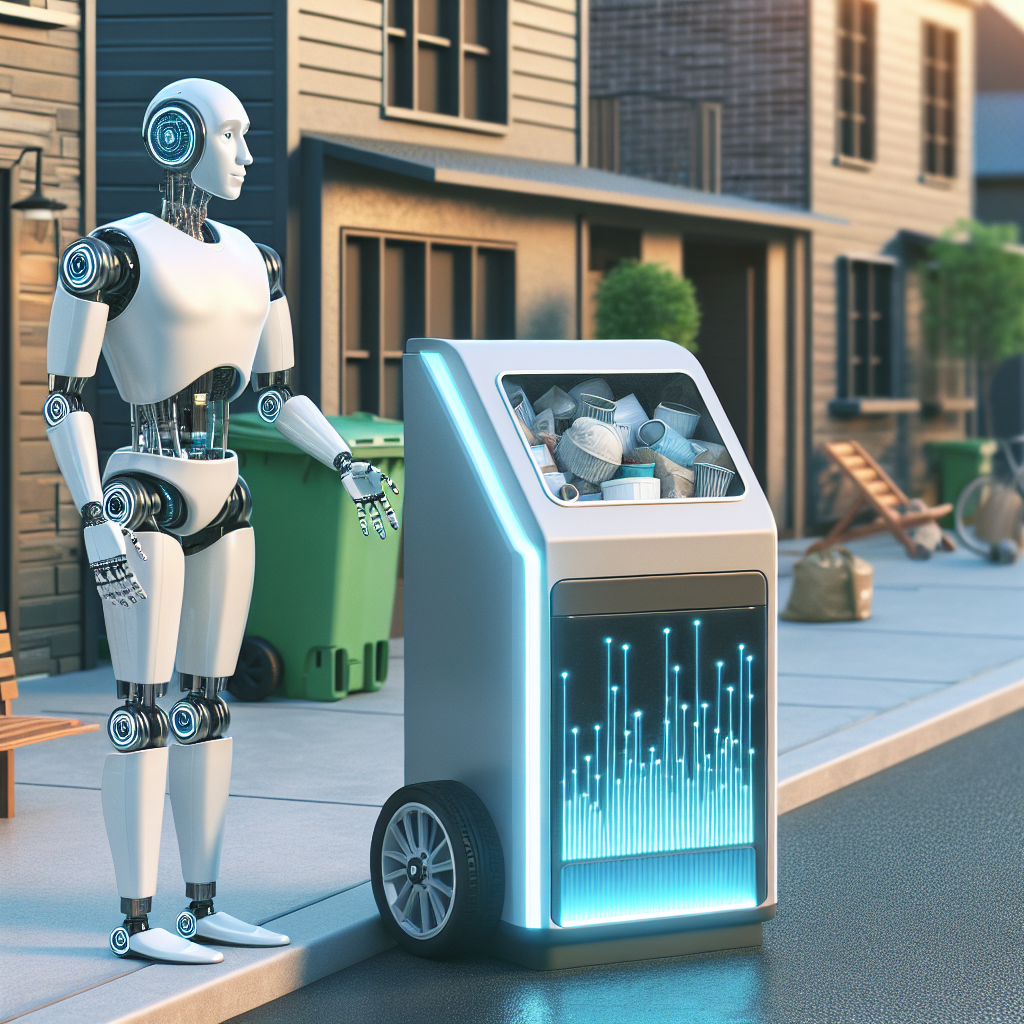Discover how AI and robotics are revolutionizing the valet trash industry, enhancing efficiency and service quality. Embrace the future of waste management today! Learn more.
Revolutionizing Waste Collection: The Role of AI in Valet Trash Services
The valet trash industry, traditionally reliant on manual labor and routine processes, is undergoing a significant transformation with the integration of artificial intelligence (AI) and robotics. This evolution is not only enhancing efficiency but also redefining the standards of service delivery in waste collection. As urban areas continue to expand and the demand for convenient waste management solutions grows, the role of AI in valet trash services becomes increasingly pivotal.
To begin with, AI technologies are being employed to optimize route planning and scheduling for waste collection. By analyzing data from various sources, such as traffic patterns, waste generation rates, and historical collection data, AI algorithms can determine the most efficient routes for collection vehicles. This optimization reduces fuel consumption and operational costs while ensuring timely service. Moreover, AI can predict peak waste generation periods, allowing service providers to allocate resources more effectively and avoid overflows or missed collections.
In addition to route optimization, AI is enhancing the sorting and processing of waste. Advanced machine learning algorithms can identify and categorize waste materials with remarkable accuracy. This capability is particularly beneficial in valet trash services, where the separation of recyclables from general waste is crucial. By automating the sorting process, AI not only increases the speed and accuracy of waste processing but also reduces the reliance on manual labor, thereby minimizing human error and improving overall efficiency.
Furthermore, robotics is playing a transformative role in the physical handling of waste. Robotic systems equipped with AI capabilities are being deployed to perform tasks such as lifting and emptying trash bins. These robots are designed to navigate complex environments, such as apartment complexes and office buildings, with ease. By taking over the physically demanding aspects of waste collection, robotics not only enhances worker safety but also allows human employees to focus on more strategic tasks, such as customer service and system maintenance.
The integration of AI and robotics in valet trash services also offers significant environmental benefits. By improving the efficiency of waste collection and processing, these technologies contribute to a reduction in greenhouse gas emissions. Additionally, the enhanced sorting capabilities of AI systems lead to higher recycling rates, thereby reducing the amount of waste sent to landfills. This aligns with the growing emphasis on sustainability and environmental responsibility in waste management practices.
Moreover, the use of AI in valet trash services is fostering greater transparency and accountability. With real-time data collection and analysis, service providers can monitor the performance of their operations and make informed decisions to improve service quality. Customers, too, benefit from this transparency, as they can receive updates on collection schedules and track the status of their waste disposal. This level of communication enhances customer satisfaction and builds trust between service providers and their clients.
In conclusion, the integration of AI and robotics into the valet trash industry is revolutionizing waste collection by enhancing efficiency, improving environmental outcomes, and elevating service standards. As these technologies continue to evolve, their impact on the industry is expected to grow, paving the way for more innovative and sustainable waste management solutions. The transformation of valet trash services through AI and robotics not only addresses current challenges but also sets the stage for a future where waste collection is smarter, safer, and more sustainable.
Automation and Efficiency: How Robotics Are Enhancing Valet Trash Operations
The integration of artificial intelligence (AI) and robotics into various industries has been a transformative force, and the valet trash industry is no exception. As urban living continues to expand, the demand for efficient waste management solutions has grown, prompting companies to explore innovative technologies to enhance their operations. The introduction of AI and robotics into valet trash services is revolutionizing the way these services are delivered, offering significant improvements in automation and efficiency.
To begin with, AI-driven systems are being employed to optimize route planning for valet trash collection. Traditionally, route planning has been a manual process, often leading to inefficiencies and increased operational costs. However, with AI, companies can analyze vast amounts of data, including traffic patterns, waste generation rates, and historical collection data, to create optimized routes. This not only reduces fuel consumption and time spent on the road but also minimizes the carbon footprint of valet trash operations. Consequently, companies can provide more reliable and timely services to their clients, enhancing customer satisfaction.
In addition to route optimization, robotics is playing a crucial role in automating the physical collection of trash. Robotic systems equipped with advanced sensors and machine learning algorithms can navigate complex environments, such as apartment complexes and residential communities, with ease. These robots are designed to handle various types of waste containers, ensuring that trash is collected efficiently and safely. By automating the collection process, companies can reduce the reliance on human labor, which not only lowers operational costs but also mitigates the risks associated with manual trash handling, such as injuries and exposure to hazardous materials.
Moreover, the use of robotics in valet trash services is contributing to improved waste sorting and recycling efforts. Robots equipped with AI capabilities can identify and sort different types of waste materials, such as plastics, metals, and organic waste, with high accuracy. This level of precision in sorting is challenging to achieve with manual labor and is crucial for enhancing recycling rates and reducing landfill waste. As a result, valet trash companies can offer more sustainable waste management solutions, aligning with the growing demand for environmentally responsible practices.
Furthermore, the integration of AI and robotics into valet trash operations is facilitating better data collection and analysis. Smart sensors and connected devices can monitor waste levels in real-time, providing valuable insights into waste generation patterns and trends. This data-driven approach enables companies to make informed decisions about resource allocation, service frequency, and capacity planning. By leveraging these insights, valet trash services can become more adaptive and responsive to the needs of their clients, ensuring that waste is managed efficiently and effectively.
In conclusion, the adoption of AI and robotics in the valet trash industry is driving significant advancements in automation and efficiency. Through optimized route planning, automated collection processes, improved waste sorting, and enhanced data analysis, these technologies are transforming the way valet trash services are delivered. As the industry continues to evolve, the integration of AI and robotics will undoubtedly play a pivotal role in shaping the future of waste management, offering more sustainable and efficient solutions to meet the demands of modern urban living.
Smart Trash Collection: The Future of Waste Management in the Valet Trash Industry
The valet trash industry, traditionally reliant on manual labor, is undergoing a significant transformation with the integration of artificial intelligence (AI) and robotics. This evolution is not only enhancing efficiency but also redefining the future of waste management. As urban areas continue to expand and the demand for sustainable waste solutions grows, the adoption of smart technologies in valet trash services is becoming increasingly essential.
To begin with, AI is playing a pivotal role in optimizing waste collection routes. By analyzing data from various sources, such as traffic patterns and waste generation trends, AI algorithms can determine the most efficient paths for collection vehicles. This not only reduces fuel consumption and operational costs but also minimizes the carbon footprint of waste management activities. Furthermore, AI systems can predict peak waste generation times, allowing service providers to allocate resources more effectively and ensure timely collection.
In addition to route optimization, AI is enhancing the sorting and recycling processes within the valet trash industry. Advanced machine learning algorithms can identify and categorize different types of waste with remarkable accuracy. This capability is crucial for improving recycling rates and reducing the amount of waste sent to landfills. By automating the sorting process, AI not only increases efficiency but also reduces the risk of contamination in recycling streams, which is a common challenge in manual sorting operations.
Moreover, robotics is revolutionizing the physical aspect of waste collection. Autonomous robots equipped with sensors and cameras are now capable of navigating complex environments to collect trash from designated areas. These robots can operate around the clock, providing consistent and reliable service without the limitations of human labor. As a result, service providers can offer more flexible collection schedules, catering to the diverse needs of residential and commercial clients.
The integration of AI and robotics also enhances safety in the valet trash industry. Waste collection is often associated with various hazards, including exposure to harmful substances and the risk of injury from heavy lifting. By automating these tasks, the industry can significantly reduce the incidence of workplace accidents and improve overall safety standards. This shift not only benefits workers but also contributes to a more sustainable and ethical business model.
Furthermore, the use of smart technologies in valet trash services aligns with the growing emphasis on sustainability and environmental responsibility. By improving efficiency and reducing waste, AI and robotics contribute to a more sustainable waste management system. This is particularly important as cities strive to meet ambitious environmental targets and reduce their ecological impact. The adoption of these technologies demonstrates a commitment to innovation and sustainability, which can enhance the reputation of service providers and attract environmentally conscious clients.
In conclusion, the integration of AI and robotics is transforming the valet trash industry by enhancing efficiency, safety, and sustainability. As these technologies continue to evolve, they will undoubtedly play an increasingly important role in shaping the future of waste management. By embracing these innovations, the valet trash industry can not only meet the demands of a growing urban population but also contribute to a more sustainable and environmentally responsible future. As we look ahead, it is clear that smart trash collection will be at the forefront of this transformation, driving progress and setting new standards for the industry.



